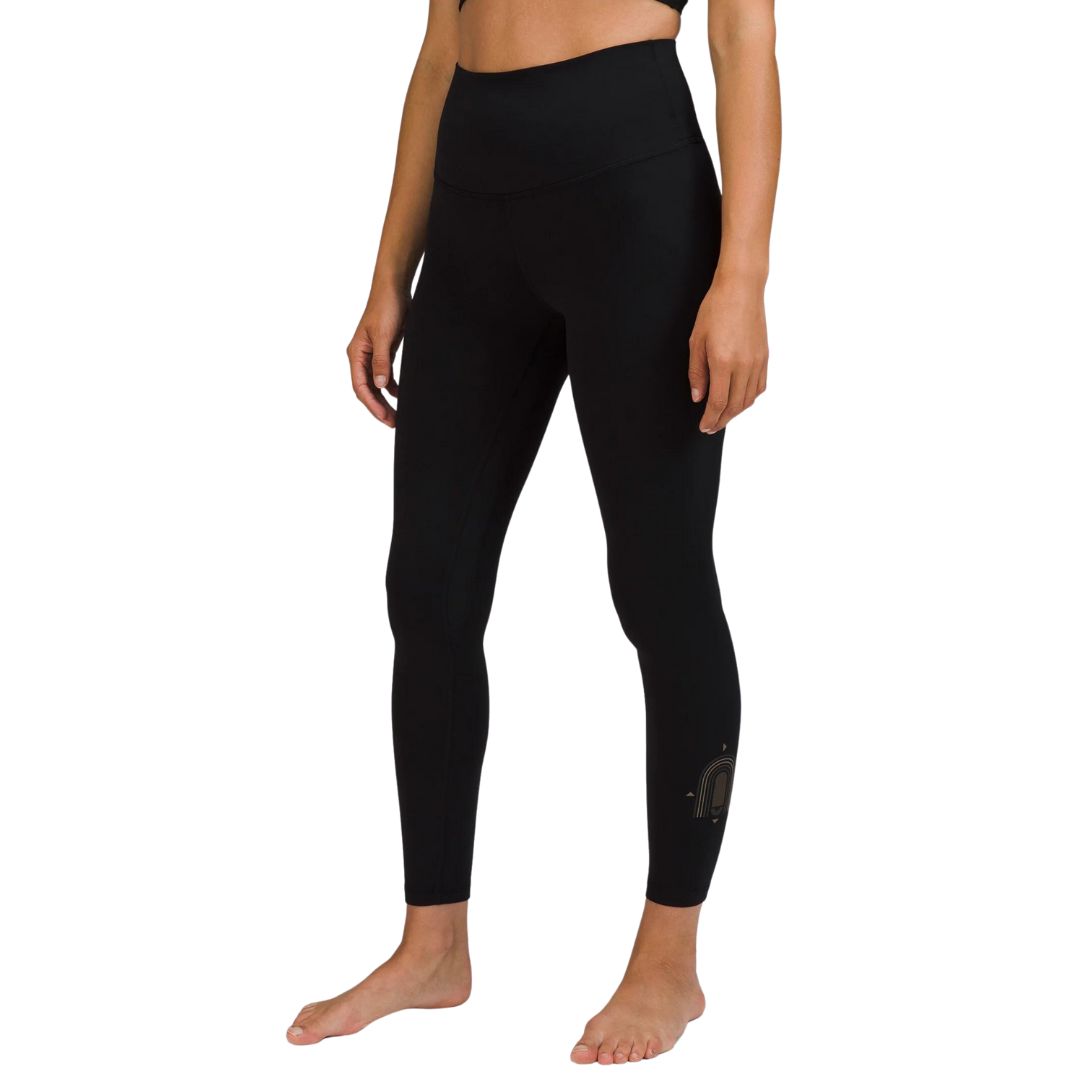I’ve Always Been Nervous Of Headstands In Yoga - But After Practising For A Week, I’m Blown Away By My Progress
Just hanging around, upside down.
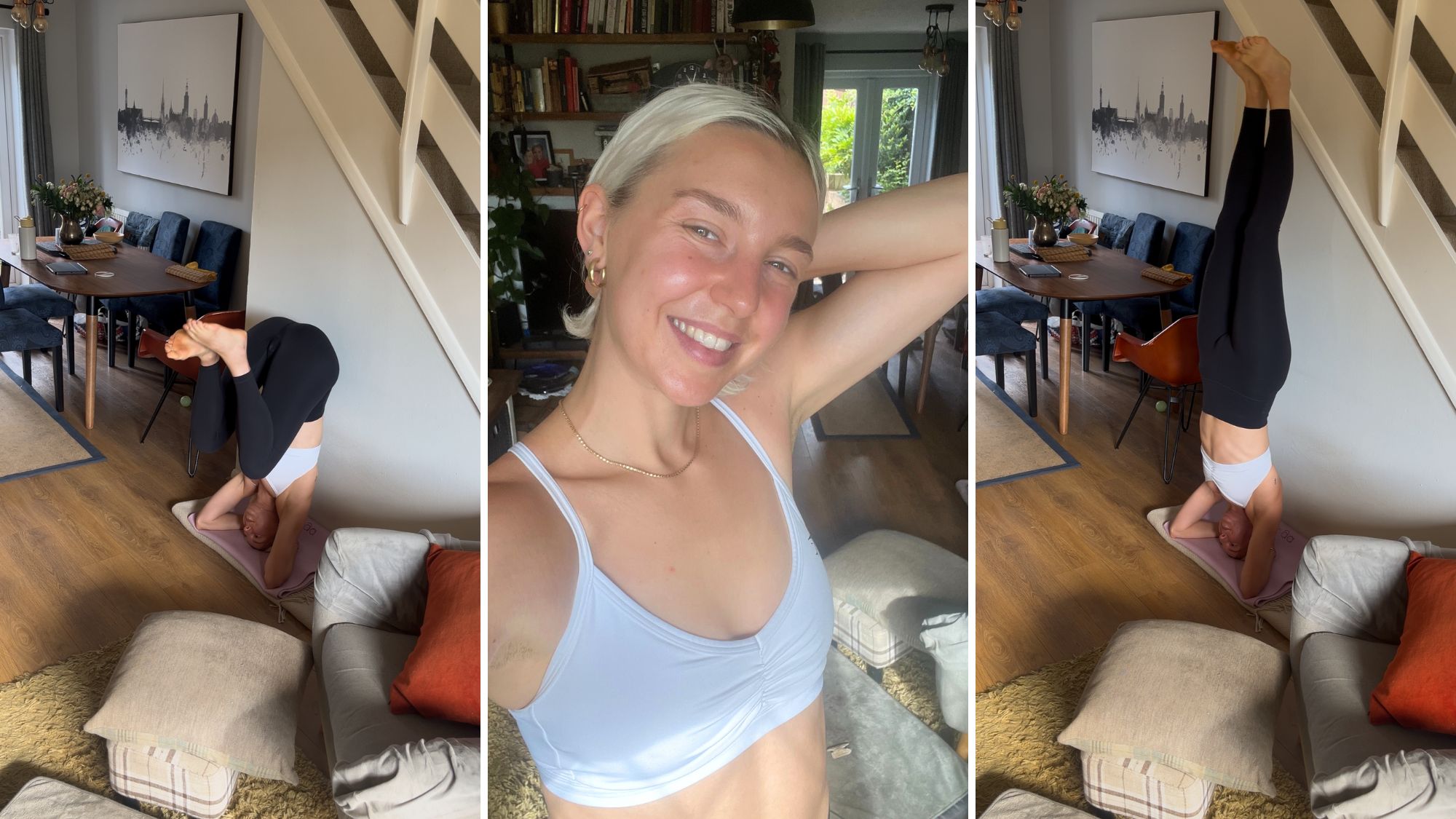

“If you have a headstand in your practice, feel free to take it now.”
I pause, consider it, measuring up the distance between me and the mats beside me. Shuffle my feet a little in preparation, and then bail, returning to my wide-legged stance with my head flopped between my knees.
I’ll try it next time, I say to myself.
Spoiler: I’ve been saying that for two years.
You see, I’m a well-practised yogi who fell in love with the practice after ending my career as a track and field athlete. I find it both physically demanding, testing my core strength, flexibility and mobility, as well as mentally challenging, requiring precision, discipline and focus.
But one move evades me: the headstand, also known as Sirsasana, or the King of the Asanas, due to its challenging nature and wealth of reported benefits - boosting core strength, blood flow, digestion and concentration.
As I headed out of class, I, for the first time, started to properly consider why I’m so scared of trying out a headstand. It occurred to me that besides the obvious potential damage to your neck and spine, there was a much larger social fear holding me back. Whereas a child, the idea of flipping upside down and falling over would have been the sign of a great game, as an adult, I was terrified of falling, crashing into my neighbour or looking silly.
Celebrity news, beauty, fashion advice, and fascinating features, delivered straight to your inbox!
And it’s clearly not just me that feels this way, with an overwhelming majority of others in classes I’ve attended also sitting out of the pose. The science supports our hesitation, with studies showing that as we transition from childhood to adulthood, we develop a play-illiteracy, where the risk of injury, busyness and social norms discourage us from experimenting with challenging or new activities. In doing so, we’re missing out on valuable mental and emotional benefits, with research showing that play has the power to help us cope with stress and improve mood by reducing cortisol levels and releasing endorphins.
All this got me thinking, could overcoming my fear of headstands be the start of a more playful life? In search of answers, I set myself the challenge of practising every day for a week, with the help of some expert tips from my most trusted yoga teachers.
Curious to see how I got on? Keep scrolling. And if you’re interested in deepening your yoga practice further, make sure you check out our guides to the best yoga flows for core strength, best yoga flows for balance, and best yoga flows for relaxation. Not your cup of tea? Don't skip our guides to yoga for energy and yoga for flexibility. Or if you're in a time crunch, scroll through the best 10-minute yoga practices, here.
It’s One Of The Trickiest Moves In Yoga - Here’s How To Master The Headstand, King Of The Asanas
What is a yoga headstand?
Headstands are not unique to yoga, but unlike those you’ll practice in gymnastics or callisthenics, a yoga headstand is about far more than flipping upside down.
As Roisin Hope, Senior Yoga Teacher & Founder of Concrete Jungle Wellness, explains, “the yoga headstand, or Sirsasana, is as much about trust, dedication and inner balance as it is about physical technique. Blending strength, flexibility, and deep focus, the yoga headstand has a meditative quality which requires intentional alignment of body and breath.”
David Ramcharran, Yoga Instructor at MoreYoga agrees, adding that in yoga, there is no jumping in and out of postures. “The concept of non-harm, or ahimsa, is the first and most fundamental ethical guideline in yoga, and it means that we move in and out of our headstands slowly and mindfully.”
There are also different variations of hand positioning within yoga headstands, which Ramcharran explains. “The Salamba Sirsasana is what we call the tripod headstand, which is a supported headstand with your hands flat on the floor. The Baddha Hasta Sirsasana is a headstand with bound hands behind the head.” The latter is often considered more challenging, as it requires more strength and stability to hold.
What are the benefits of practicing a yoga headstand?
They’re notoriously intimidating, but besides being able to flex a new skill in class, what’s actually the point of learning to do a headstand?
Well, according to the experts, the benefits are vast and varied. “Physically, it gives you an incredible full-body workout, building upper body and core strength, increasing hamstring flexibility, and improving balance,” says Hope, “but more than anything, it resets your mindset. In going upside down, you are literally shifting your perspective, challenging your own mental barriers, learning patience, resilience and how to move through fear.”
Ramcharran points out that there are also huge benefits for our circulatory system, which is responsible for transporting oxygen and nutrients around our body, and which is crucial for supporting our immune system and hormone distribution. “Headstands improve blood circulation to the head, which has the potential to enhance concentration and mental clarity, whilst also promoting hair growth and a healthy skin glow,” he explains. “At the same time, reversing the effects of gravity on the digestive organs can relieve gas and aid digestion.”
How to perform a yoga headstand with good form
So far, so convinced. But before I dive into my week-long trial, I’m keen to make sure I’m nailing my form and minimising my risk of injury, so I turn to Ramcharran for his best beginner tips.
“I always start by teaching students the tripod headstand,” he tells me, “because it’s the easiest one to learn.”
1. Get comfortable
“Start by making sure that your neck is comfortable,” says Ramcharran. “Set up against a wall, and if working on a hard floor, you can use a blanket for added comfort. If your hair is tied up or in a bun, I always suggest loosening it, so that it isn’t on the top of your head. ”
2. Nail your alignment
“Rest the back of your head up against a wall, and make sure you feel supported. Place your hands flat with your palms facing down and forward, with your elbows up. Out of the corner of your eye, you should be able to see your fingertips. From here, you’re ready to start going upside down.”
Ramcharran is quick to point out that if at any stage you feel neck pain or discomfort, you should slowly exit the movement.
3. Move slowly
“Once you feel comfortable, place your knees on top of the upper arms, moving gradually to find your balance. From here, you can start to place the soles of the feet on the wall, before sliding your legs up the wall.”
4. Maintain your balance
Once in a full headstand, Ramcharran suggests flexing your feet so that they are flat up towards the ceiling, as this will help to maintain stability.
5. The exit is just as important
“Never jump out of the pose,” says Ramcharran, “as this can lead to neck injury.” Instead, he advises us to “slide your feet down and place the knees back on the upper arms.” Or, if it feels more comfortable, he says that you can bring one leg straight down whilst leaving the other on the wall for support.
I Added a Headstand To My Yoga Practice Every Day For a Week. After Seven Days Of Practice, Here’s What I’ve Noticed
Days one - three
Confession: I delayed starting my headstand trial for over a week before I finally got stuck in. I made every excuse not to commit to the practice: I was in a rush, I had a headache, there were too many people around…the list was endless.
But with a deadline looming, I knew I had to face my fear. Wanting to avoid any early wobbles in front of others, I picked a day when I was working from home and had the house to myself.
Finding a suitable wall was the first challenge. I needed space free from anything fragile items within kicking distance (I’m 5ft 9 with quite the wingspan, so knocking over a vase mid-headstand wasn’t something I fancied). Once I’d cleared the area, I laid out my yoga mat, twice folded for extra cushioning, and took a deep breath.
I’d planned to start with the tripod headstand. The experts had recommended it as the most stable variation and therefore the best option for beginners. Lying my palms flat on the floor facing the wall, I rested the top of my head between them so that I was in a triangular (or tripod) shape.
Following the alignment tip I’d been given, I flicked my eyes from right to left to ensure I could just glimpse my fingertips in my peripheral vision - a good indicator I was in the right position.
From there, I slowly began to walk my feet up towards my hands, coming into a pike position, before gingerly placing one knee on my forearm, then the other, bringing my toes together in the middle.
I was surprised to find how comfortable and balanced I was here, and there was very little wobbling to speak of.
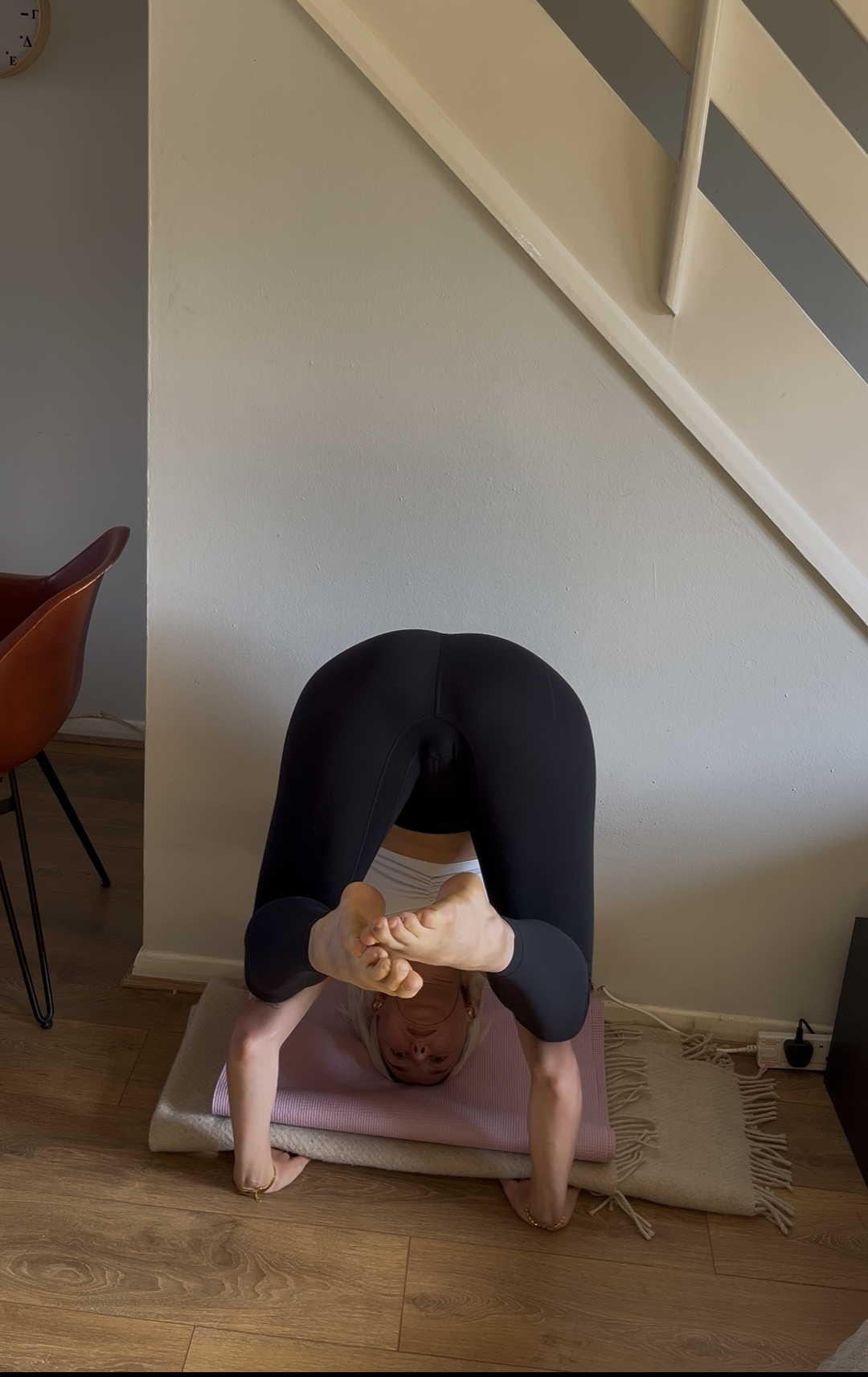
Phase one of Ashleigh learning to headstand: knees against forearms and toes connected in the middle
So far, so good, or so I thought. When I tried to lift one leg away from my arm and straight up against the wall, I found myself a little stuck. No matter what I tried, each time I tried to lift a leg, I’d lose balance and end up falling out of the pose. My core didn’t feel strong enough, and my mind wasn’t brave enough to fully commit.
Keen to take my time and not scare myself off by rushing into things, I stuck with the bent knee position, getting used to the feeling of being upside down, for the rest of the day’s practice.
When day two dawned, I was determined to progress. I added an extra blanket on top of my yoga mat this time, as I’d really felt the pressure on the top of my head the day before. It wasn’t painful per se, but being upside down leaves you feeling a little dizzy, and I wanted to make sure my head was as protected as possible.
After a few attempts, I found it actually felt easier to move into the full headstand in one fluid motion, rather than pausing with my knees on my arms. I was careful not to swing my legs up, as my teachers had reminded me that a yoga headstand is about slow, controlled movement.
Once I reached the full inversion, I felt surprisingly stable, especially when I followed the tip to dorsiflex my feet at the top of the movement (meaning, the soles face up towards the ceiling). I couldn’t hold the position for more than a few seconds without one leg drifting, but I was closer than I’d expected to a full, supported headstand. I practised around 5 reps to get used to the feeling, before calling it a day.
Back at my desk, I was shocked by how awake I felt. Any lingering morning fog had completely lifted, and I could actually feel the increased circulation around my head.
By day three, I was keen to challenge myself to hold the headstand for a little longer. I set a timer and eased up into position. Once I’d found my balance, I focused on breathing evenly and activating my core, arms and legs - lifting tall from my centre and reaching upwards.
This helped, and I managed to hold a headstand for 42 seconds, which felt like significant progress in just three days of practice.
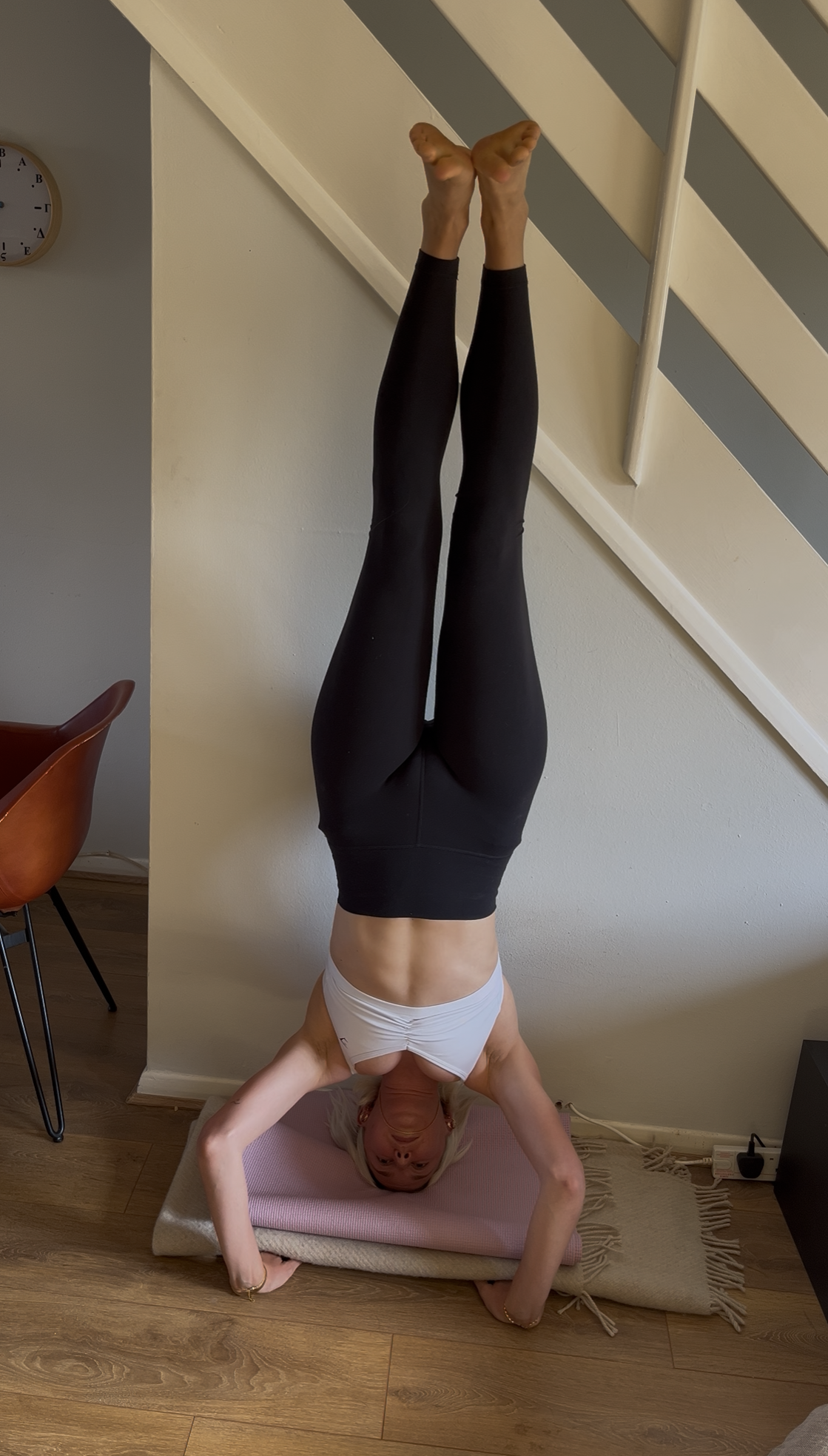
Ashleigh reaches a full tripod headstand on day two of her practice
Days four to seven
By day four, I was genuinely excited to end my yoga practice with a headstand. The nerves I’d felt at the beginning of the week had dissipated, and I decided it was time to try in the studio for the first time. At the start of class, I asked if a headstand could be included in the session, and fortunately, the instructor already had it planned.
I chose a mat near a wall for reassurance. The studio was busier than I’d have liked, with mats placed close together, but when the moment came, I took a deep breath and focused on the cues I’d been drilling over the past few days. Once I’d found that sweet spot (fingertips in sight, head stable), I slowly lifted my legs into position.
I didn’t stay up long and made sure to rest in child’s pose afterwards to counter the inversion, but it was my first public headstand, and nothing major went wrong, which was a huge win in my mind.
On day five, I was really noticing the benefits of a daily headstand practice. I felt that it really added another energising layer to my practice, especially in the morning, setting my day up for a focused and positive start.
Having got the hang of the tripod headstand, I was interested to see if I could give the more advanced version, with my hands bound behind my head, a go. Interestingly, I actually preferred how this positioned me slightly further back on my skull, which felt more comfortable.
That said, a quick word of caution: this variation does bring you closer to the wall, and I found my legs more easily rested against it. It made it tempting to rely on that support, so I had to stay really focused on keeping my feet bolt upright and resisting the urge to lean.
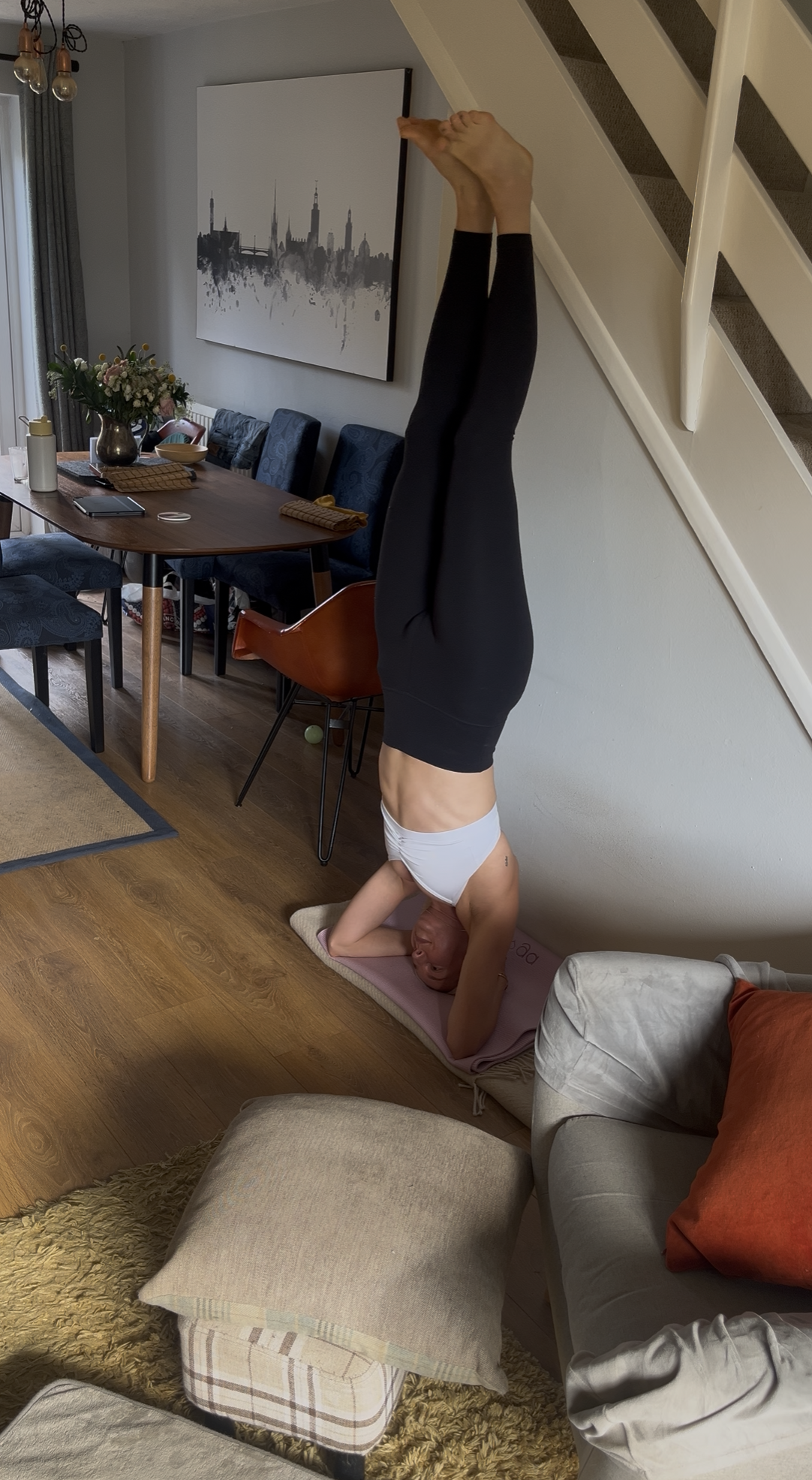
By day five, Ashleigh experiments with another headstand variation - this time with hands behind her head
Over the final two days, I alternated between the tripod and bound-arm variations, quickly realising I preferred the latter. I still wobble, and my success rate of holding the pose for more than 20 seconds is only around 50%, but I was shocked at how quickly I picked it up, and the improvement I saw day by day was actually really empowering.
If you’re looking for an energising morning practice, I’d genuinely recommend adding a headstand to your routine. Just a few minutes upside down gave me a huge boost in focus, and my productivity in that first hour post-practice shot up. I also found it a great stress reliever when I was feeling the pressure, or when I’d had too much screen time. Stepping away from my laptop for two minutes to hang out upside down was an instant mental reset, and one I’ll now be using consistently going forward.
My only advice? Take it slow, and drink plenty of water when you come out of the pose. The head rush can feel intense at first, and you’ll need a few seconds to reorient yourself.
Other than that, it’s a big yes from me. Headstands have officially earned a spot in my daily routine. They’re energising, empowering, and, let’s be honest, a bit of a flex in class.
Shop MC UK's go-to kit now:
Does it matter if I don’t want to do a headstand in yoga?
There’s a common misconception that being able to do a headstand is the ultimate sign of an accomplished yogi, but according to Roisin Hope, Senior Yoga Teacher & Founder of Concrete Jungle Wellness, this is certainly not the case.
“Headstands can be empowering and fun, but they are not the measure of your practice,” says Hope. “If inversions don’t serve you physically or energetically, that’s totally fine. Being able to sit with a calm, focused mind is far more meaningful and useful than any shape you can make with your body.”
“I actually think the beauty of yoga is that it’s not possible to master it,” she goes on. “It’s a lifelong practice of learning, unlearning, and evolving, and what matters most is that your practice feels authentic to you. Progress in yoga is personal, not performative.”

A former heptathlete, Ashleigh is a freelance journalist, specialising in women’s health, wellbeing and lifestyle, with words in Stylist, Cosmopolitan, Glamour and Marie Claire. She’s also the Co-Founder of Sunnie Runners, an inclusive London based run club.
